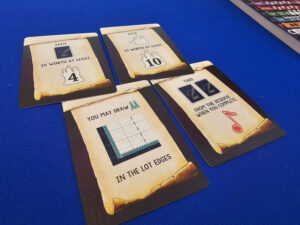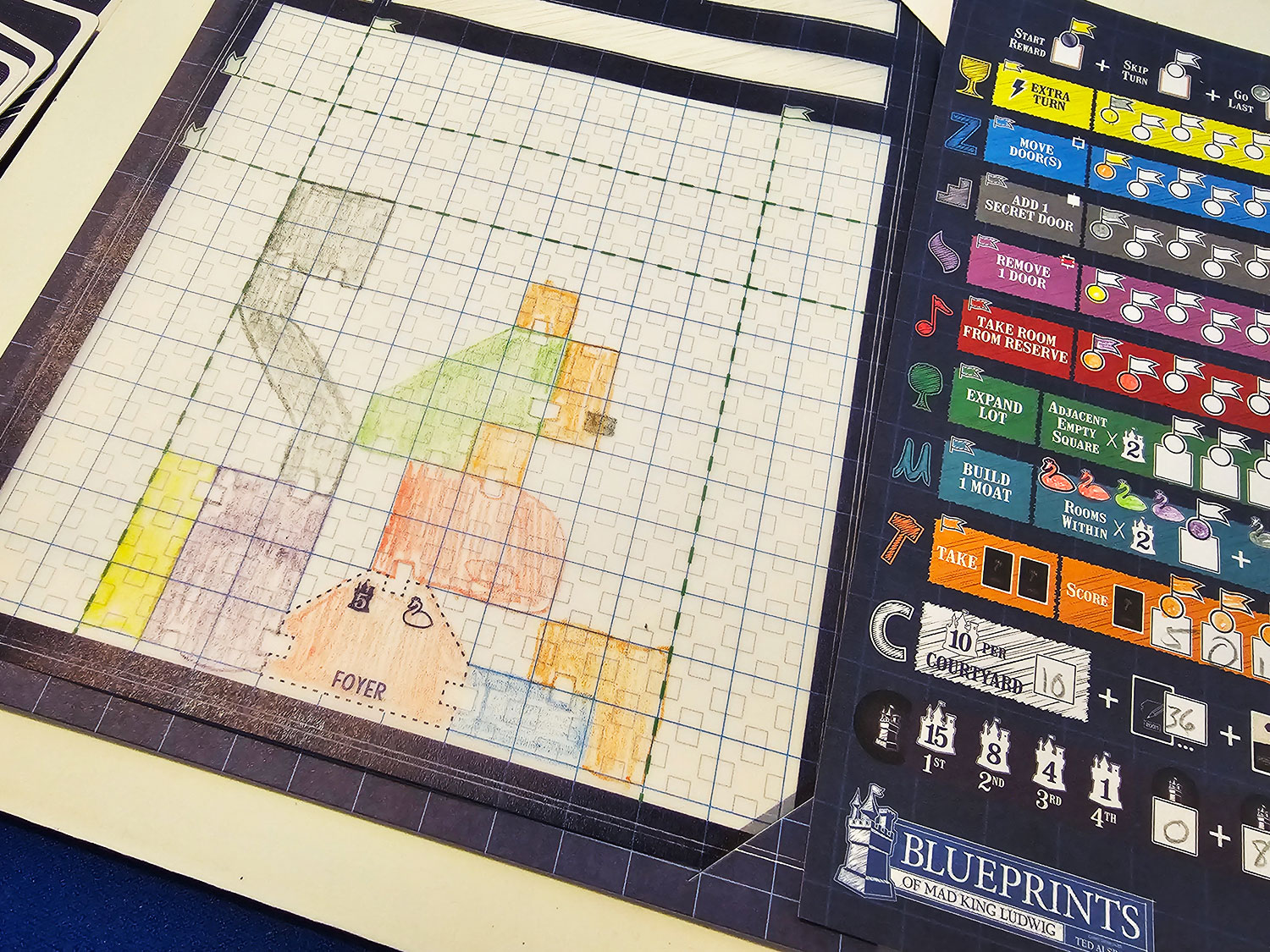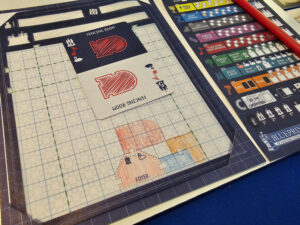
 As most of my dear readers know, I’m the resident Movie Person here at Board Game Quest, so I view most things through that lens. Keeping that in mind: do you know how a lot of modern media is very concerned with “shared universes”? This superhero movie needs to be watched after that superhero TV show or the context is ruined? Well today’s board game review has similar trappings.
As most of my dear readers know, I’m the resident Movie Person here at Board Game Quest, so I view most things through that lens. Keeping that in mind: do you know how a lot of modern media is very concerned with “shared universes”? This superhero movie needs to be watched after that superhero TV show or the context is ruined? Well today’s board game review has similar trappings.
Blueprints of Mad King Ludwig is the fourth game in the Mad King Ludwig Shared Universe (to be referred to as the “MKLSU” for brevity going forward). It’s kinda like, but also kinda different than most of the others and plays 1-5 And takes roughly 60 minutes to play.
Gameplay Overview:
Some of the things in Blueprints of Mad King Ludwig will be very similar to other entries in the MKLSU, but this game does alter the formula a bunch. For starters, Blueprints is a draft-and-write game. Players will be drafting room types of different shapes and sizes and drawing them with various colored pencils into their private castle grids.

Each room has a certain number of doors that must be linked up with doors of other rooms already present in the castle. Once a room is completely closed off (i.e., all the doors connect to other rooms), players earn a unique Room Reward based on the room type. There are a bunch of these rewards in the game, range from extra turns all the way to increased bonus scoring opportunities. These Rewards can be triggered immediately or saved for later.
The draft is based on the value of the rooms drafted into the previous round (player who drafted the lowest-valued room picks first) and all the rooms are free of charge. Once drafted, players must be able to fit the room into their available grid (this is expandable as the game progresses) and can do so freehand or use the game’s pretty neat dual-paneled player sheet contraption to slide the new card underneath and trace the room shape. (I say “pretty neat,” but I have some issues with this concept I’ll expound upon later.)
This is the general game flow for every turn. There are some wrinkles thrown in via the optional Royal Decree cards, which essentially serve as variable player powers. Once the Room deck is exhausted, the game is over and players will add up their points. Everyone scores for their added rooms, bonuses, making courtyards (enclosed outdoor spaces with a door within your castle walls), and where they ranked in the King’s Favors which is comparative scoring in a variety of types. Person with the best score? Best castle-person ever. (That is, of course, until the next entry in the MKLSU.)

Game Experience:
Blueprints of Mad King Ludwig is a weird game. During setup, it all seems fairly straightforward, and the actual gameplay looks like it’ll be a blast to play. The writing “pads” are actually thick, translucent stock and everyone mounts their board on a cardboard piece. This is how everyone can later slide the drafted room cards underneath to trace. Honestly, it was really neat setting these up and getting pumped to play. (“Let’s draw some freakin’ multicolored castles!”) But once the game started, this novelty quickly evaporated. Drawing the rooms is a pain—the shapes range from “tiny” to “utter chaos”—and the “sliding under the top sheet” thing never quite works in the exact way I feel like it was meant to.

Those are process issues more than game design issues to be fair, but that doesn’t mean I don’t have issues with the game design itself. The concept of a MKLSU blank-and-write game seems like a no-brainer and I do give designer Ted Alspach credit for not making this a direct port of the original game, but for me, this is one of those bloated-beyond-all-reason blank-and-writes. The first few turns are simple and fun as players can just draw whatever they want and do a little bit of planning. By the fourth turn, however, the grid is comically tight, most people have made mistakes where they’ve previously drawn their doors (which are little rectangles that are “punched out” of each room), and turns can drag on as a lot of this mechanical stuff is sorted out.
On top of logistical stuff (thematic, I suppose, for a game about architecture), the scoring and bonus calculations are—in a word—maddening (which ::giggle:: is also thematic). There are dozens, nay, billions of things to run the numbers on each turn. Does this bonus counteract that bonus? Should I trigger this previous Room Reward now or save it for later when, mercifully, the math might be easier to parse. Am I winning the King’s Favors race against my opponents and if I’m not sure should I ask them all to give me a count of where they stand in every category? I may sound like I’m exaggerating but I’m really not. It’s a real headspin. And I’m not even talking about some of the wackier Room Rewards which involve moving doors around from previous rooms, which is another wild calculation that I did not enjoy.
Final Thoughts:
Blueprints of Mad King Ludwig feels a lot like the concept of Cartographers extrapolated a million-fold. The drawing aspect is kinda fun, but maximizing points on each turn is, to put it mildly, mind-numbing. I know there’s a market for complex roll-and-write games and this might very well hit with fans of those, but the math in this one has a lot of moving parts. The game feels like an exercise in concept over gameplay; it’s a pretty good idea bogged down by very iffy gameplay. I’ve played every entry in the MKLSU and to varying degrees, I’ve liked them all. But like all the others after the first—which is a favorite of mine—playing Blueprints of Mad King Ludwig just made me wish I was playing Castles of Mad King Ludwig.
Final Score: 2.5 Stars – A good idea that has too much going to be as fun as it could have been.
 Hits:
Hits:
• Good production values
• Easy enough to learn the rules but…
Misses:
• …learning the scoring complexities is something of a nightmare
• Turns can drag even though the game isn’t that long
• Some of the components have usability issues
• (Not mentioned above, but some of the King’s Favors are silly and annoying. For instance, players can get points if they have a “mildly amusing name” for their castle. Huh?)









